Albumen Gallery are bringing architecture & emptiness to
Unseen Amsterdam
At the annual Unseen Amsterdam photography fair,
London-based online Albumen Gallery are presenting four photographers who explore
emptiness in architecture, carrying stories & histories within the silence.
With works from Edmund Sumner, Thomas Kemnitz, Robert Conrad & Steven
Seidenberg, historic architecture & contemporary projects are visited, all
intermingling with an eerie & haunted sense of distance & abandonment.
Unseen Amsterdam, the festival of photography held in the Dutch capital over one weekend each year, has a burst of architecture this
year with Albumen Gallery’s offering. One of 70 galleries showing in the
main Participants Fair held in the culture park Westergas, an industrial
site dating from the late 19th century which has since become a
city-centre site of art and events.
Now in its 12th edition, it has an international gaze. Albumen Gallery is an online gallery based in London and landing for local events such as Unseen. Their presentation in Amsterdam brings four photographers looking at architectural landscapes in conversation with one another, with Robert Conrad, Steven Seidenberg, Robert Kemnitz, and Edmund Sumner each presenting vantages upon abandonment and emptiness.
![]()
![]()
![]()
If you’re a ruinlust fan, then this is the quartet for you, especially with Thomas Kemnitz’s images of decay, patina, and romantic roughage of found spaces across Germany. Behind each location and image is a depth of research, with the artist seeking to present a sense of the former function, occupants, and history of the place beneath the carefully composed and alluringly lit spaces.
Born in Schönebeck, in what was once Soviet East Germany, the artist is interested in the industrial, political, and social histories of the buildings he discovers – images at Unseen covering all these interests, with a substation control room, STASI command centre, and a ballroom. The ballroom is in Grünau at the edge of modern-day Berlin and on the banks of the Dahme River, once a place where up to 50,000 people would escape the city for rowing, fresh air, and partying. It continued as a place of dancing from the 1890s right through pop and disco into the 1990s before closing down – now only existing as a shell following looting and fires.
![]()
![]()
![]()
![]()
Edmund Sumner might need no introduction to British readers with an interest in architecture, with the photographer’s images recording contemporary architecture in publications and books for the last three decades. Here, Sumner escapes the clutches of capturing seductive shots of modern buildings for promotion and publicity, delving into his personal interests of desolation, abandonment, and deserted architectures.
While his commercial practice takes Sumner to new projects by the likes of RSHP, Conran and Partners, and Tadao Ando, the places depicted for Albumen are a little different. An image of the Crisis Management Department Building in Minamisanriku is tafter Miki Endo, an employee who broadcast information about Japan’s 2011 tsunami to the public who was washed away from the second floor.
But Sumner also shows places in transition, not just after such devastation, in a mix that questions why and how a place is empty. An image shows the grand space of Peckham Station’s Waiting Room, paired back by Benedict O’Looney Architects, Le Corbusier’s Neelam Cinema in Chandigarh carries the marks of thousands of filmgoers, and carved out rock spaces show David Chipperfield Architects’ raw transformation of the Cava Arcari cave complex near Vicenza, Italy – once a stone quarry, now a performance space.
![]()
![]()
![]()
Another former East German photographer, Robert Conrad, captures remnants of the former ideology. Born in 1962, Conrad moved to East Berlin from his childhood home on the Baltic sea in his 20s as his interest in photography and architecture developed. He tasked himself with documenting the disappearing buildings, all the time while watched by the STASI and prevented from studying architecture at university until after 1989.
Conrad passed away last year, but he is represented at Unseen by works taken after the fall of the wall but which look back through different political periods within empty spaces. A telephone booth within a closed-off underground station, the desolate Unter Den Linden U-Bahnhof, and the abandoned Beelitz Sanatorium in Berlin, once a huge military hospital where Hitler was treated in World War one and Erich Honecker, the Chairman of the State Council of East Germany, spent time at the end the Soviet regime.
![]()
![]()
![]()
Steven Seidenberg is not only a photographer, but also a poet and writer. His images seek to carry that sense of the lyrical and narratives beyond the frame. The artists has travelled the world seeking such silent drama in architectures and public spaces, from documenting hospital waste in Thailand to squats in Rome, the fogs of neolithic Dorset to tape used to repair urban infrastructure in Tokyo.
At Unseen, Albumen Gallery are showing images from Seidenberg’s series and book The Architecture of Silence, capturing abandoned homes across the south of Italy. The sense of past personal value and care compressed into buildings with no economic value brings forward ideas about what home, place, and shelter is. With rich Italian light picking up colour-washed surfaces, while the series is punctuated by escape from the faded homes with vast rolling, agricultural landscapes.
The main Participants Fair is supplemented by Participants Unbound, with seven galleries presenting monumental photographic installations using video, performance, sensory experience, virtual reality, sculpture, and landscape within the large Transformatorhuis hall and surrounding park. On top of this, there’s also a vast photographic book fair with over 60 international photographic publishers large and small presenting new publications alongside talks and signings.
![]()
Now in its 12th edition, it has an international gaze. Albumen Gallery is an online gallery based in London and landing for local events such as Unseen. Their presentation in Amsterdam brings four photographers looking at architectural landscapes in conversation with one another, with Robert Conrad, Steven Seidenberg, Robert Kemnitz, and Edmund Sumner each presenting vantages upon abandonment and emptiness.



Figs.i-iii
If you’re a ruinlust fan, then this is the quartet for you, especially with Thomas Kemnitz’s images of decay, patina, and romantic roughage of found spaces across Germany. Behind each location and image is a depth of research, with the artist seeking to present a sense of the former function, occupants, and history of the place beneath the carefully composed and alluringly lit spaces.
Born in Schönebeck, in what was once Soviet East Germany, the artist is interested in the industrial, political, and social histories of the buildings he discovers – images at Unseen covering all these interests, with a substation control room, STASI command centre, and a ballroom. The ballroom is in Grünau at the edge of modern-day Berlin and on the banks of the Dahme River, once a place where up to 50,000 people would escape the city for rowing, fresh air, and partying. It continued as a place of dancing from the 1890s right through pop and disco into the 1990s before closing down – now only existing as a shell following looting and fires.




Figs.iv-vii
Edmund Sumner might need no introduction to British readers with an interest in architecture, with the photographer’s images recording contemporary architecture in publications and books for the last three decades. Here, Sumner escapes the clutches of capturing seductive shots of modern buildings for promotion and publicity, delving into his personal interests of desolation, abandonment, and deserted architectures.
While his commercial practice takes Sumner to new projects by the likes of RSHP, Conran and Partners, and Tadao Ando, the places depicted for Albumen are a little different. An image of the Crisis Management Department Building in Minamisanriku is tafter Miki Endo, an employee who broadcast information about Japan’s 2011 tsunami to the public who was washed away from the second floor.
But Sumner also shows places in transition, not just after such devastation, in a mix that questions why and how a place is empty. An image shows the grand space of Peckham Station’s Waiting Room, paired back by Benedict O’Looney Architects, Le Corbusier’s Neelam Cinema in Chandigarh carries the marks of thousands of filmgoers, and carved out rock spaces show David Chipperfield Architects’ raw transformation of the Cava Arcari cave complex near Vicenza, Italy – once a stone quarry, now a performance space.
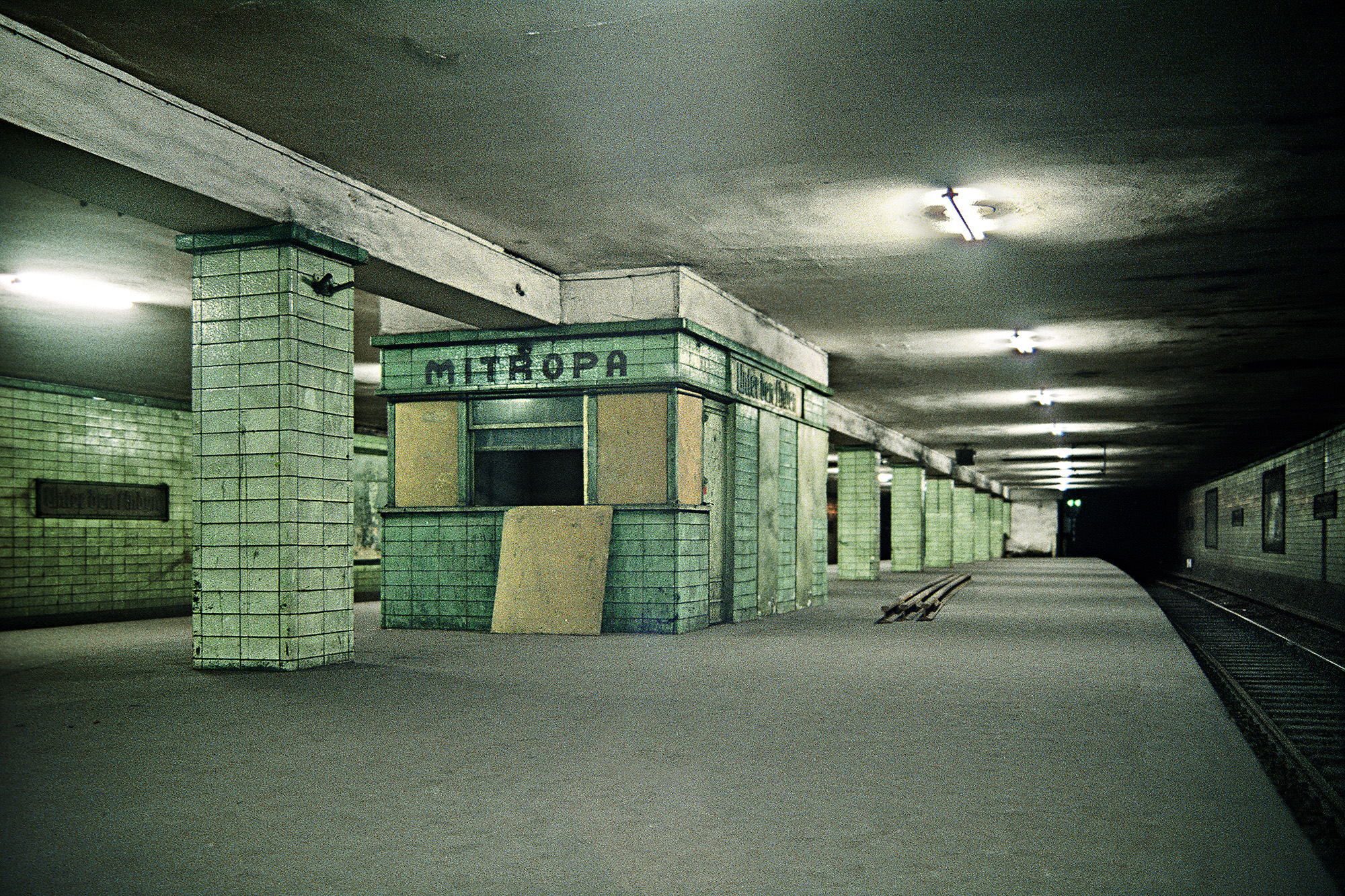
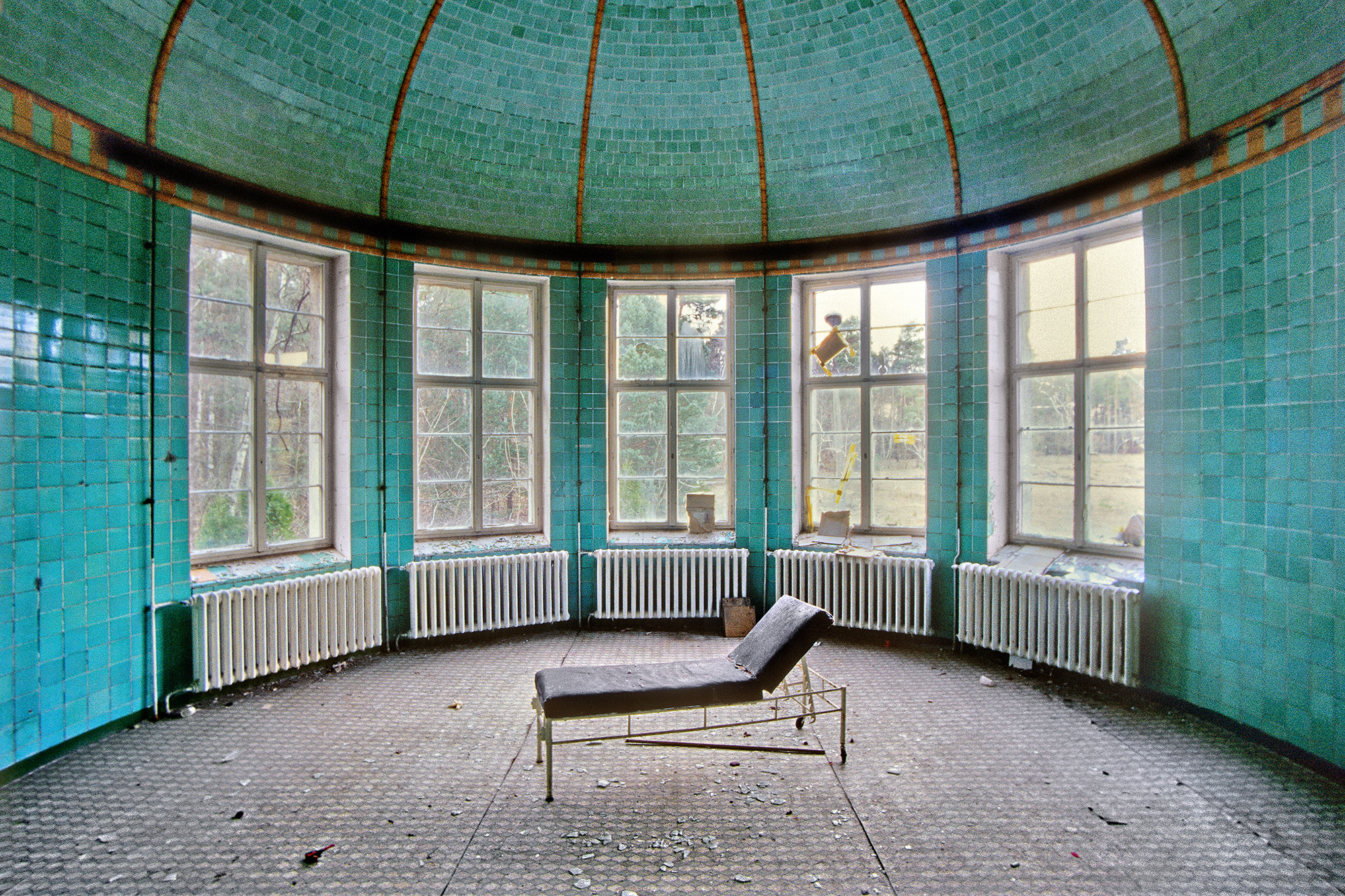
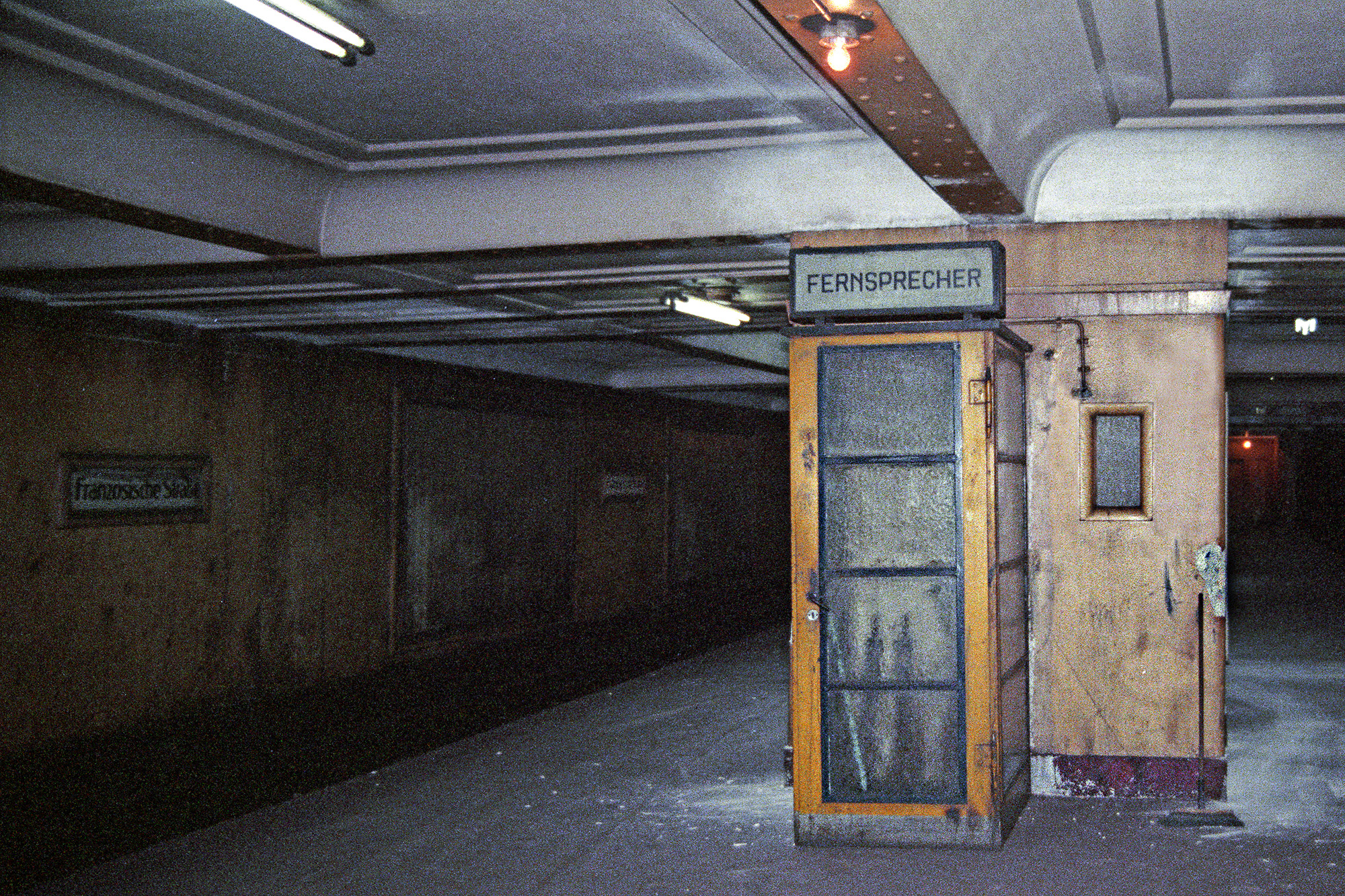
Figs.viii-x
Another former East German photographer, Robert Conrad, captures remnants of the former ideology. Born in 1962, Conrad moved to East Berlin from his childhood home on the Baltic sea in his 20s as his interest in photography and architecture developed. He tasked himself with documenting the disappearing buildings, all the time while watched by the STASI and prevented from studying architecture at university until after 1989.
Conrad passed away last year, but he is represented at Unseen by works taken after the fall of the wall but which look back through different political periods within empty spaces. A telephone booth within a closed-off underground station, the desolate Unter Den Linden U-Bahnhof, and the abandoned Beelitz Sanatorium in Berlin, once a huge military hospital where Hitler was treated in World War one and Erich Honecker, the Chairman of the State Council of East Germany, spent time at the end the Soviet regime.
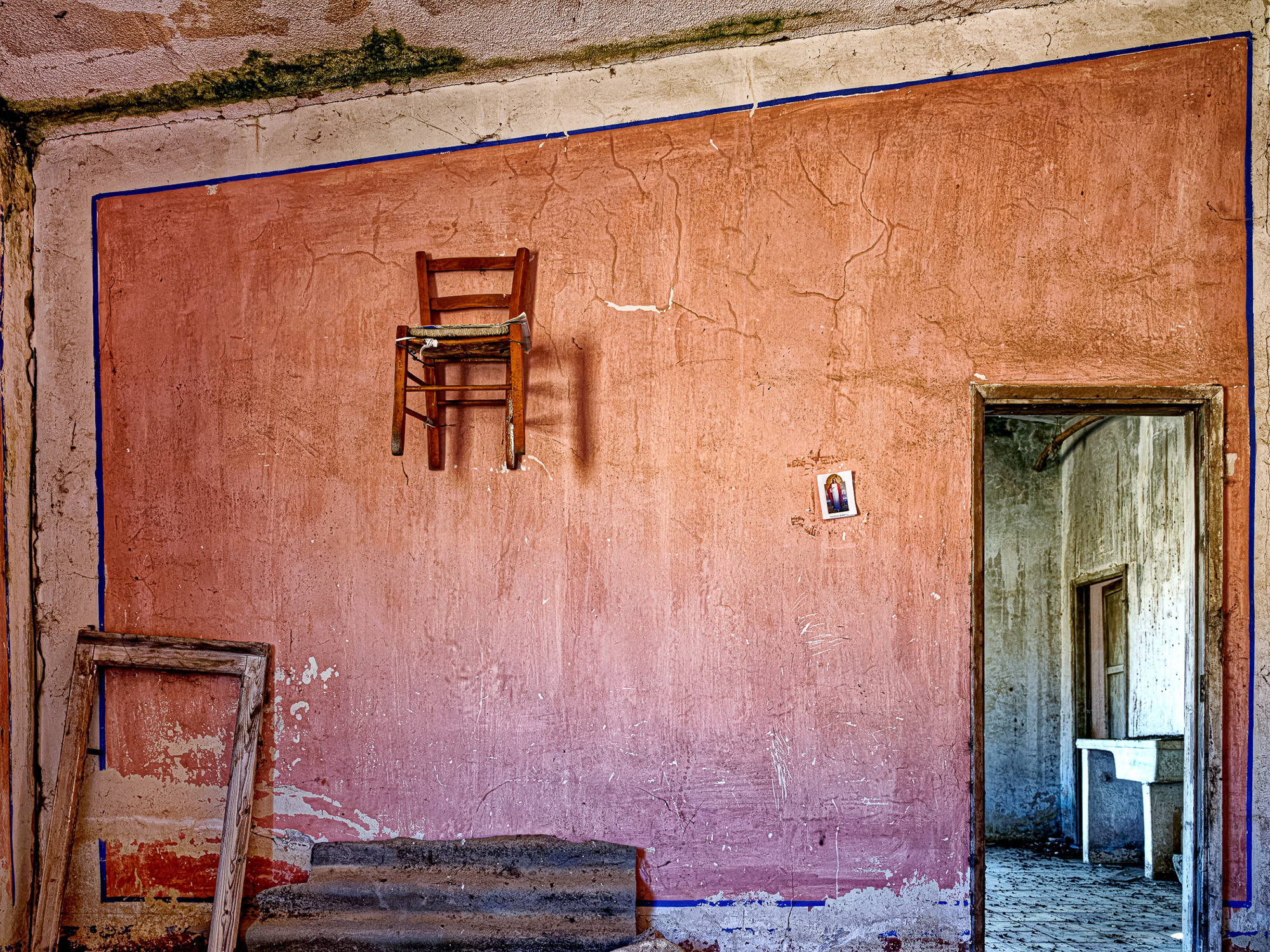


Figs.xi-xiii
Steven Seidenberg is not only a photographer, but also a poet and writer. His images seek to carry that sense of the lyrical and narratives beyond the frame. The artists has travelled the world seeking such silent drama in architectures and public spaces, from documenting hospital waste in Thailand to squats in Rome, the fogs of neolithic Dorset to tape used to repair urban infrastructure in Tokyo.
At Unseen, Albumen Gallery are showing images from Seidenberg’s series and book The Architecture of Silence, capturing abandoned homes across the south of Italy. The sense of past personal value and care compressed into buildings with no economic value brings forward ideas about what home, place, and shelter is. With rich Italian light picking up colour-washed surfaces, while the series is punctuated by escape from the faded homes with vast rolling, agricultural landscapes.
The main Participants Fair is supplemented by Participants Unbound, with seven galleries presenting monumental photographic installations using video, performance, sensory experience, virtual reality, sculpture, and landscape within the large Transformatorhuis hall and surrounding park. On top of this, there’s also a vast photographic book fair with over 60 international photographic publishers large and small presenting new publications alongside talks and signings.
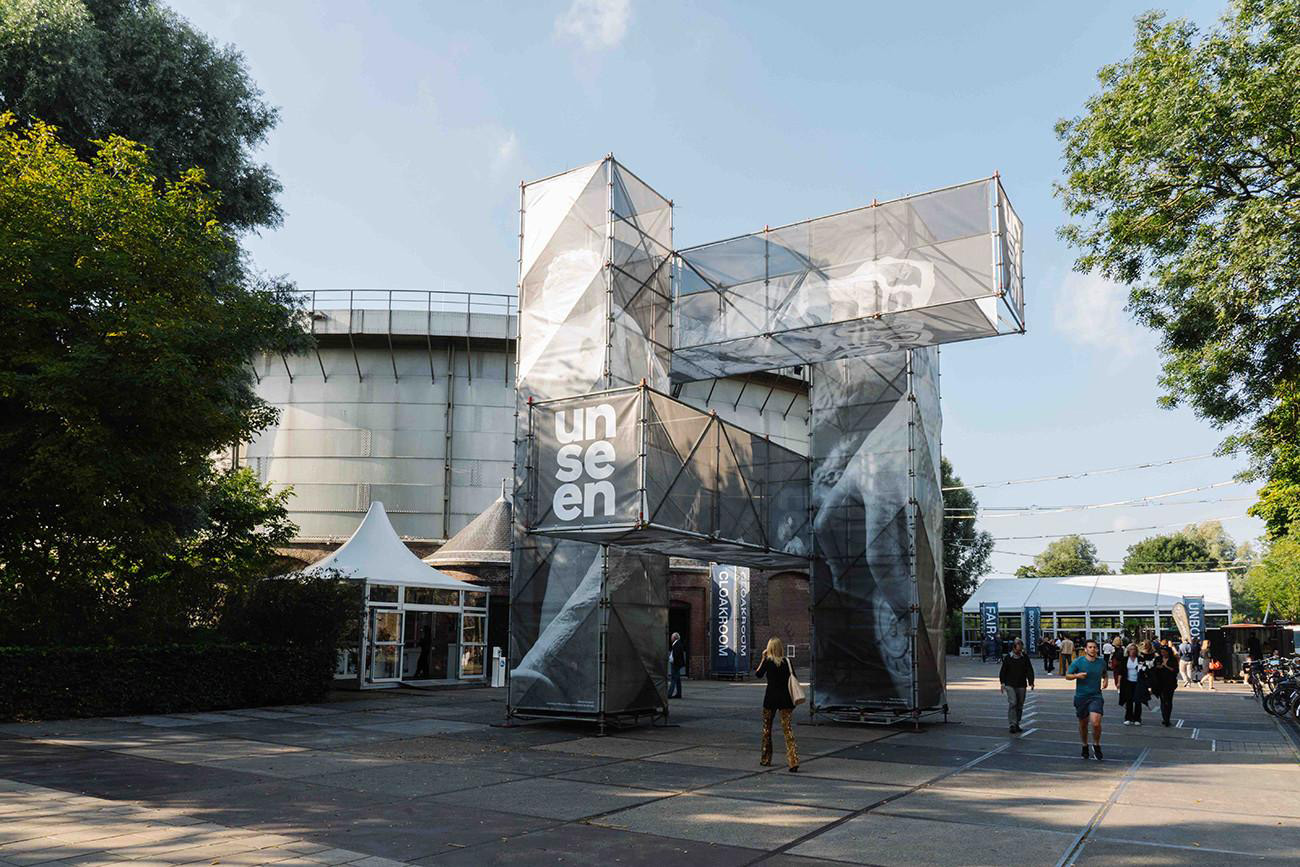
Fig.xiv
Unseen Amsterdam is the leading international art fair for
contemporary photography. Internationally acclaimed for its high curatorial
standards and intimate atmosphere, the fair attracts galleries and collectors
from all over the world. The Unbound Foundation is an independent extension of
Unseen, specifically dedicated to researching the boundaries of the photographic
universe. In 2021, Unseen launched the first edition of Unbound with an
exhibition of 15 groundbreaking projects selected by Marcel Feil, former
artistic director of Foam Fotografiemuseum Amsterdam. For each new edition,
Unbound chooses a different guest curator. For 2022, this was Damarice Amao
from the Centre Pompidou in Paris.
https://unseenamsterdam.com
Albumen Gallery was set up in London in 2013. Specialising in 20th century &
contemporary photography Albumen Gallery responds to shifting trends in how
photographic art is experienced & purchased by collectors. In a world where
online immediacy & global availability become accepted & expected,
Albumen Gallery eschews a permanent brick & mortar gallery space targeting
through its online exhibition programme a wider international audience. The
gallery's online presence is firmly coupled with a dedicated personalised
customer and advisory service.
Pioneering the online gallery without walls concept, Albumen
Gallery is continuously developing the format & potential of online
exhibitions as an accepted platform for exhibiting art photography. The Albumen
Gallery Publishing series accompanies each exhibition with a dedicated photo
book.
www.albumen-gallery.com
Robert Conrad was a German photographer who grew up in
Greifswald (former GDR) & moved to East Berlin in the 80s. Early on,
Robert Conrad became disenchanted with the authoritarian socialist regime &
his regime-critical political stance coalesced with a passion for architecture &
photography; documenting historical buildings before they would disappear
became Robert Conrad’s mission. Throughout the 80s he was kept under
observation by the STASI as an undesirable regime critic. As a result of this
he was barred from studying architecture at university & had to survive on
casual manual labour. After the fall of the GDR he did eventually study
architecture at Berlin University. His work mainly focused on architecture & urban
landscapes.
www.albumen-gallery.com/robert-conrad
Steven Seidenberg is a photographer & writer whose collections
of photographs include The Architecture of Silence (Contrasto, 2023) &
Pipevalve: Berlin (Lodima Press, 2017) with solo exhibitions of his work in
Japan, Italy, Germany, Mexico & the United States. He is the author of
numerous collections of lyric, philosophical prose & poetry, most recently Anon(Omnidawn, 2022), plain sight (Roof Books, 2020) & Situ(Black Sun Lit, 2018). His books have appeared in Swedish, Italian & Portuguese
translation.
www.albumen-gallery.com/product-category/photographers/steven-seidenberg
www.stevenseidenberg.com
Thomas Kemnitz, born in Schönebeck, teaches Design & Photography at
Hochschule für Wirtschaft & Technik Berlin. He is the Co-founder of the
research project 'Virtuelles Museum der Toten Orte (VIMUDAP). His publications
include STILLGELEGT, jointly published with Robert Conrad & Michael
Träger. The aim of Thomas Kemnitz’s visual
exploration and documentation is to do justice to the object: targeted
research and responsible publication are at the beginning of a process that
does not lose sight of the context and ultimately contributes to the media
preservation of the place through reflection and communication hand in hand.
www.albumen-gallery.com/thomas-kemnitz
Edmund Sumner, a London-based photographer with a global
portfolio, has spent the past three decades capturing the various facets of
modern architecture. His work is recognized for its ability to convey the
formal and spatial aspirations of contemporary design while maintaining a
balance between style & environmental context. Sumner’s work is widely
published, with publications including: Architecture of Eden (Transworld
2004), New Architecture in Japan (Merrell, 2010), Architecture of the
Olympics (Wiley, 2012) & Indian House (Thames and Hudson 2020).
Solo exhibitions include Human Landscapes at Browse & Darby (2006) & Outside the Box – Images of Contemporary Architecture at Daiwa
Foundation (2011).
www.albumen-gallery.com/edmund-sumner
www.edmundsumner.co.uk
visit
Unseen Amsterday runs from 19-22 September, further details
available at: www.unseenamsterdam.com/practical
Albumen Gallery can be visited at: www.albumen-gallery.com
images
fig.i Thomas Kemnitz - Control Room, Substation Humboldt (2020)
fig.ii Thomas Kemnitz - STASI Command Centre, Berlin (2014)
fig.iii Thomas Kemnitz - Riviera Grünau, Großer Ballsaal, Berlin (2010)
fig.iv Albumen Gallery - Edmund Sumner Peckham Waiting Room
© Edmund Sumner
fig.v Albumen Gallery - Edmund Sumner Miki Endo 遠藤 未希 (Japan after the Storm 2012)
©
Edmund Sumner
fig.vi Albumen Gallery - Edmund Sumner Neelham Cinema
©
Edmund Sumner
fig.vii Albumen Gallery - Edmund Sumner Cava Arcari
©
Edmund Sumner
fig.viii Robert Conrad - U-Bahnhof Unter Den Linden (1990)
fig.ix Robert Conrad - Beelitz Sanatorium (1996)
fig.x Robert Conrad - Telephone Booth on platform of sealed off Underground Station (1990)
fig.xi Steven Seidenberg SS Hanging Chair and Madonna - Italian Architecture Photography (2017)
fig.xii Steven Seidenberg SS Vanity - Italian Architecture Photography (2019)
fig.xiii Steven Seidenberg SS Blue Room with Fig - Italian Architecture Photography (2017)
fig.xiv unseen amsterdam
©
Almicheal Fraay
publication date
19 September 2024
tags
Abandomment, Albumen Gallery, Amsterdam, Berlin, Robert Conrad, Documentary, East Germany, Emptiness, History, Thomas Kemnitz, Photography, Ruinlust, Steven Seidenberg, Edmund Sumner, Unseen Amsterdam, Urban exploring, Westergas
Albumen Gallery can be visited at: www.albumen-gallery.com


